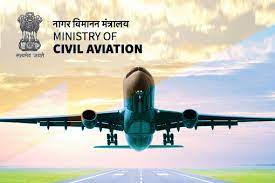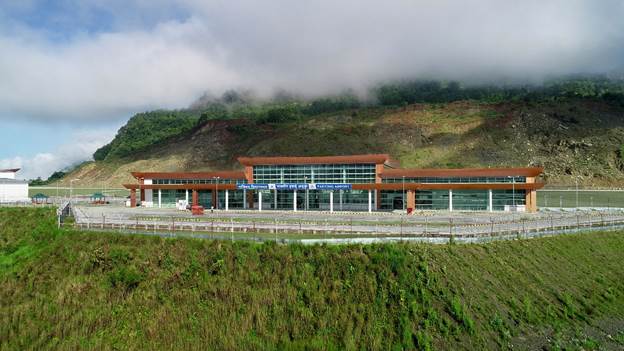
Initiatives taken by MoCA to promote sustainable development in the aviation sector and reduce carbon emissions at airports
Sustainable Aviation Fuel use is being encouraged
Steps being taken for reduction of Green House Gases in airspace
AAI has prepared Roadmap for achieving 100% Renewable Energy for airports
The Voice of Chandigarh News:

India’s aviation sector has experienced rapid growth in recent years, leading to an increase in carbon emissions from airports. Ministry of Civil Aviation (MoCA) has taken a number of initiatives to promote sustainable development in the aviation sector and reduce carbon emissions at airports
Green House Gas emission from airports can be categorized in three scopes:
Scope 1- Emissions from airport-owned or controlled sources. Examples include airport-owned power plants that burn fossil fuel, conventional vehicles that use gasoline, or conventional GSE that use diesel fuel.
Scope 2-Indirect emissions from the consumption of purchased energy (electricity, heat, etc.)
Scope 3-Indirect emissions that the airport does not control but can influence. Examples include tenant emissions, on-airport aircraft emissions (typically, after an aircraft is parked on the apron), emissions from passenger vehicles arriving or departing the airport, and emissions from waste disposal and processing.
As per analysis, Scope 1 contributes 5% and Scope 2 contributes to 95% to the total direct emission from airports.
Green airports: A green airport is an airport that has implemented sustainable practices to reduce its environmental impact and promote sustainable development. Green airports aim to minimize their carbon footprint, conserve energy & water resources, reduce waste and emissions.

Initiatives taken by MoCA to sensitize stakeholders:
To promote sustainable development in the aviation sector and reduce carbon emissions at airports, MoCA has taken following measures:
- MoCA organized knowledge sharing sessions to standardize Carbon Accounting and Reporting framework of Indian Airports as well as to create awareness on Climate Change mitigation.
- Advised all the operational Brownfield Airports and upcoming Greenfield Airports operators to:
- Work towards achieving Carbon Neutrality & Net Zero which inter-alia includes use of 100% Green Energy.
- Get Accreditation by Airports Council International (ACI)/ISO 14064 through empaneled verifiers.
- Adopt Carbon Mitigation Measures as well as Carbon Management plans with milestones.
- Advised all the Chief Secretaries/Administrators to ensure Carbon Emission reduction measures and achieving Net Zero target ab-initio by incorporating design/standards in the Greenfield airport development proposal, DPR, Airport Master plan etc. before sending the same to MoCA.
- Advised Airports Economic Regulatory Authority to consider the cost associated with the Green Energy use for Airport Tariff Determination.
Steps taken by the MoCA for encouraging usage of Sustainable Aviation Fuel (SAF):
ICAO has launched Carbon Offsetting & Reduction Scheme for Aviation (CORSIA) to reduce emissions from international aviation which require offsetting of emissions above a baseline value. CORSIA Scheme is envisaged in 3 phases:
- Pilot Phase – (2021-2023)
- First Phase – (2024-2026)
- Second Phase (2027-2035)
Pilot and first phases are voluntary phases whereas second phase is mandatory for all the ICAO member States. Government of India has decided not to participate in the voluntary phases of CORSIA. Offsetting requirement under CORSIA for Indian carriers will start from 2027.
- Airlines can either use SAF or offset their emissions by purchasing carbon credits from ICAO approved Emissions Unit Programmes.
- In the 41st ICAO General Assembly, the baseline of CORSIA has been revised to be 85% of 2019 emissions. Also, the Individual Growth Factor (IGF) for airlines has been reduced to 0% from 20% in 2030-32 compliance cycle and to 15% from 70% in the final 2033-35 compliance cycle.
- To realize the goals of decarbonization of Aviation Sector, Ministry of Petroleum & Natural Gas constituted a Bio-Aviation Turbine Fuel (ATF) Programme Committee to take forward the Bio-ATF programme in the country to promote use of clean fuels.
- The Bio-ATF Programme Committee has submitted its report to MoP&NG for approval.

IDENTICAL PHOTO
- SpiceJet, a private Indian carrier, had conducted a demonstration flight with Bombardier Q400 aircraft in August 2018 using bio-fuel blended with ATF (in the ratio of 25:75) in one engine.
- MoCA and DGCA have held meetings with the Indian carriers to sensitize them regarding the impact of CORSIA on airlines once the mandatory phase starts and the resultant need to be prepared for the same.
- As on date, Airbus and Boeing aircraft are capable of flying with up to a 50% blend of SAF. Both the manufacturers aim to enable 100% SAF capability by 2030.
- Clean Skies for Tomorrow (CST) is an initiative of the World Economic Forum to help the aviation sector move towards net-zero emissions by accelerating the use of sustainable aviation fuels. Representative of CST Coalition is a member of the Bio-ATF Programme Committee. Airlines, airports, SAF producers and OEMs are part of the CST Coalition.
Initiatives taken by airports:
- Adoption of advanced technologies and automation
- Energy efficient HVAC & lighting system
- Energy efficient baggage handling systems etc.
- Building design as per Green building Standards
- Use of daylighting concepts
- Adoption of environment friendly material
- Development of onsite solar power plant
- Use of renewable energy through offsite mechanism such as open access, long term Power Purchase Agreement (PPA) etc.
- Implementation of Airport Collaborative Decision Making (A-CDM)
- Stakeholder engagement & discussions etc.
Initiatives by MoCA taken for reduction of Green House Gases(GHG) in airspace:
- Flexible Use of Airspace (FUA): Due to Flexible Use of Airspace, cumulative reduction in carbon emission of approx. 90,000 tCO2 in addition to cumulative saving of approx. INR 400 crore on ATF expenses has been achieved since its implementation in August, 2020. Further, about 128 CDRs (Conditional Routes) have been promulgated since implementation of FUA in consultation & coordination with IAF, MoD.
- Implementation of Central Air Traffic Flow Management (C-ATFM): This management technique is helping AAI to manage air traffic flows strategically in the Indian sky, which has helped to ensure reduced delays & holding and optimisation of capacity, leading to reduction in fuel consumption and GHG emissions.
The C-ATFM system was operationalized in January 2017, India thereby becoming the 7th country in the world (after USA, Europe, Australia, South Africa, Japan and Brazil) to implement the Air Traffic Flow Control Measures across the country. Due to implementation of C-ATFM, estimated saving of approx. 2141 tonnes of ATF has been achieved during calendar year 2022 which resulted in the reduction in carbon emission by approx. 6767 tCO2.
- Implementation of Performance Based Navigation (PBN): PBN supports development of air routes / arrival-departure paths / approach procedures which help reduce/optimise track miles, descent and climb profile and thereby enhance airspace capacity. These measures improve operational efficiency of aircraft operations and lead to reduction in fuel consumption and GHG emissions.
- Implementation of Continuous Descent Operations (CDOs): CDOs have been implemented to permit aircraft to maintain a very fuel-efficient arrival flight path, which helps reduce fuel consumption and noise at ground, thereby reducing GHG Emissions.






Airports Council International – Global Framework
The Airports Council International (ACI) has launched the Airport Carbon Accreditation program, which is a global standard for carbon management at airports. The program helps airports to assess their carbon emissions, develop a carbon management plan, and reduce their carbon footprint.
Achievements:
- Delhi and Mumbai airports, the top two major airports in the country, have achieved the highest Level 4+ Carbon Accreditation of ACI. As on date, there are only three airports in Asia-Pacific, who have achieved this feat.
- Hyderabad and Bengaluru have also achieved the status of being Carbon Neutral (Level 3+).
- AAI at Kolkata, Bhubaneswar and Varanasi Airports has achieved Level 2 Airport Carbon accreditation in Dec’ 2019 and is in process of ACI-ACA Level 2 certification for 23 more airports.
- AAI has already installed Solar Power Plants at various airports with cumulative capacity of more than 54 MWp as on date. AAI is also procuring around 53 million units of solar energy through open access and green power tariff, thus enhancing Renewable Energy (RE) share as on date to about 35% of total electrical consumption of AAI airports.
- Most of the Airports have given the target of achieving 100% use of Green Energy by 2024 and Net Zero by 2030.
- Mumbai, Cochin and 25 AAI Airports are using 100% Green Energy. Cochin Airport is the first green airport in the world, fully powered by solar energy.
- AAI has given targets to achieve 100% Green Energy at its remaining operational airports by 2024. A roadmap in this regard is at Annexure.
- Almost all the major airports have Sewage Treatment Plants (STPs) installed at their sites and at remaining airports the STPs are being installed
- Airports Authority of India has chalked out the plan for its scheduled operational airports and has taken initiatives such as Energy Intensity Data publication, reducing energy intensity for existing as well as upcoming airport projects.
- A training module has been created as a part of induction training programme for Air Traffic Controllers to sensitize them towards Carbon Neutrality.
- Implementation of Airport Collaborative Decision Making (A-CDM) has resulted in enhancement of ground operational efficiency by encouraging intersection departures, thereby leading to reduction in fuel and GHG emissions.
- Provisioning of Taxi Bots for Green Taxiing is being undertaken as a pilot project at Chennai & Kolkata Airports for towing aircraft without running its engines, which would save burning of ATF, thereby leading to reduction in GHG emissions.




Annexure
AAI’s Roadmap for achieving 100% Renewable Energy
| Achieved(25 Airports) | Puducherry, Kanpur (Civil), Hubballi, Belagavi, Mysore, Tezu, Kangra, Shimla, Kullu, Jammu, Srinagar, Leh, Imphal, Pakyong, Pantnagar, Dehradun, Dimapur, Jalgaon, Kohlapur, Pune, Aurangabad, Gondia, Akola, Sholapur, Juhu |
| To be Achieved by Mar 2023(13 Airports) | Bhubaneswar, Jharsuguda, Gorakhpur, Kushinagar, Hindon, Varanasi, Prayagraj, Bareilley, Moradabad, Jabalpur, Bhopal, Salem, Tuticorin |
| To be Achieved by Jun 2023(12 Airports ) | Meerut, Khajuraho, Indore, Begumpet, Kanpur (Chk), Kadappa, Gwalior, Trichy, Coimbatore, Madurai, Chennai, Cooch Behar |
| To be Achieved by Dec 2024(46 Airports) | Ayodhya, Tirupati, Rajamundhary, Lilabari, Porbandar, Hollongi, Deoghar, Keshod, Vizag, Surat, Goa, Kalaburagi, Kandla, Safdarjung, Bhavnagar, Agra, Rupsi, Jamnagar, Agartala, Bikaner, Jaisalmer, Bhuj, Rajkot, Raipur, Gaya, Darbhanga, Patna, Tezpur, Jorhat, Kota, Calicut, Dibrugarh, Jodhpur, Kishangarh, Ranchi, Vijayawada Amritsar, Udaipur, Adampur, Ludhiana, Bhatinda, Pathankot, Diu, Barapani, Silchar, Vadodara |
